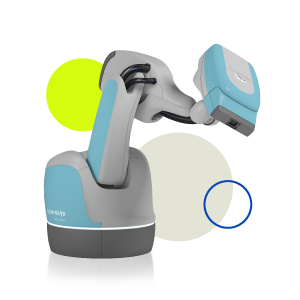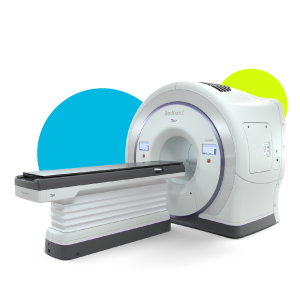CASE STUDY | CYBERKNIFE® TREATMENT DELIVERY SYSTEM
Proven Efficacy of the CyberKnife® System for the Treatment of Trigeminal Neuralgia
The largest prospective, single-institution, homogenous series of trigeminal neuralgia patients treated with the CyberKnife® System was published in the journal Neurosurgery1 . This study provides robust clinical data supporting the efficacy of the CyberKnife System for this neurological condition. CyberKnife frameless radiosurgery offers a precise, non-invasive technique with clinical outcomes comparable to Gamma Knife frame-based radiosurgery. The following table summarizes the findings.
Study Title
Image-guided Robotic Radiosurgery for Trigeminal Neuralgia
Principal Investigator
Dr. Pantaleo Romanelli, Neurosurgeon, Centro Diagnostico Italiano, Milan, Italy
Design
Single-institution, homogenous and prospectively followed cohort
Number of Patients Analyzed
138 patients
Time Period
Between November 2010 and March 2014
Follow-up
Minimum and median follow-up was 36 and 52.4 months respectively
Dose Prescription
Single-fraction dose of 60 Gy delivered to a 6-mm long segment of the nerve
Typical Treatment Plan Example

Efficacy
Pain relief was achieved in 93.5% of patients after a median delay of 3 weeks after treatment. This is comparable to the 91.0% after a median delay of 10 days reported in the largest Gamma Knife frame-based radiosurgery study2.
Recurrence
Pain recurred in 18.6% of patients within 3 years of the treatment. This is favorably comparable to the 34.4% reported in the largest Gamma Knife frame-based radiosurgery study2.
Toxicity
An overall rate of 18.1% of patients developed sensory disturbances. This is comparable to the 20.4% sensory disturbances reported with Gamma Knife frame-based radiosurgery3.
Open Access Link
The 93.5% of patients who achieved pain relief were able to decrease the dose of the medication intended to control the pain throughout follow-up and finally cease the pain medication. Nine patients (6.5%) who did not experience pain relief after 6 months, and 24 patients (18.6%) whose pain recurred within 3 years of treatment, underwent a second treatment with CyberKnife. All 33 patients attained pain relief after the second treatment.
SUB-MILLIMETER PRECISION AND ACCURACY
Monthly quality assurance tests at the Centro Diagnostico Italiano demonstrated a median total treatment error of 0.30±0.12 mm1 . The system delivered the sub-millimeter precision and accuracy necessary for treatment of trigeminal neuralgia.
TRIGEMINAL NEURALGIA
Trigeminal neuralgia is a chronic pain condition affecting a craniofacial nerve that is primarily responsible for transmitting sensations from the face to the brain. This severe pain, quoted by patients as the most atrocius human beings can suffer, requires long-term medical treatment1 . The treatment usually starts with medications to lessen or block the pain signals sent to the brain. Over time, some patients stop responding to medications or suffer from unpleasant side effects. For those patients, ablative treatments such as glycerol injections, radiofrequency lesioning, balloon compression, surgery, or radiosurgery lesioning are alternative treatments.
RADIOSURGERY
Lars Leksell pioneered radiosurgery with the Gamma Knife System (Elekta AB, Stockholm, Sweden) in 19514. This radiosurgery system directs focused beams of radiation to the nerve, damaging the nerve and reducing or eliminating the pain. Sub-millimeter precision and accuracy is required for this treatment. This has been achieved with the Gamma Knife System using an invasive stereotactic frame fixed to the patient’s skull.
CYBERKNIFE® RADIOSURGERY
The CyberKnife® System (Accuray Incorporated, Sunnyvale, California) is also used for the treatment of trigeminal neuralgia5-8. Its image guidance technology enables sub-millimeter precision and accuracy without an invasive stereotactic frame8-10. This eases the treatment for patients and gives the physician the option to fractionate the treatment in multiple sessions. While trigeminal neuralgia patients are treated in single session, other neurological indications close to sensitive structures such as the spine or optic apparatus may benefit from multisession radiosurgery. A custom-fitted thermoplastic mask secures the patient in treatment position. X-ray images are continually acquired throughout treatment to track any shift and gradual drift. The CyberKnife 6-axis robotic arm then aims each beam of radiation taking into account any translational and rotational changes. All displacements are automatically corrected, regardless of how small, maintaining sub-millimeter accuracy, preserving conformal dose distribution, and sparing the surrounding critical structures and normal tissues.

1. Romanelli P, Conti A, Bianchi L, Bergantin A, Martinotti A, and Beltramo G: Image-guided Robotic Radiosurgery for Trigeminal Neuralgia. Neurosurgery. Nyx571, 2017
2. Tuleasca C, et al: Patterns of pain-free response in 497 cases of classic trigeminal neuralgia treated with Gamma Knife surgery and followed up for least 1 year. Journal of Neurosurgery. 117 Suppl:181-188, 2012
3. Regis J, et al: Long-term safety and efficacy of Gamma Knife surgeryin classical trigeminal neuralgia: a 497-patient historical cohort study. Journal of Neurosurgery. 124:1079-1087, 2016
4. Leksell L, et al: Sterotaxic radiosurgery in trigeminal neuralgia. Acta Chir Scand. 137:311-314, 1971
5. Adler J, et al: Nonisocentric radiosurgical rhizotomy for trigeminal neuralgia. Neurosurgery. 64:A84-90, 2009
6. Romanelli P, et al: Cyberknife radiosurgery for trigeminal neuralgia. Stereotactic and Functional Neurosurgery. 81:105-109, 2003
7. Villavicencio AT, et al: Cyberknife radiosurgery for trigeminal neuralgia treatment: a preliminary multicenter experience. Neurosurgery. 62:647-655, 2008
8. Romanelli P, Conti A, Bianchi L, Bergantin A, Martinotti A, and Beltramo G: Image-guided Robotic Radiosurgery for Trigeminal Neuralgia. Neurosurgery. Nyx571, 2017
9. Antypas C. and Pantelis E. Performance evaluation of a CyberKnife G4 image-guided robotic stereotactic radiosurgery system. Phys Med Biol. 53:4697-4718, 2008 10. Drexler and Furweger. Quality assurance of a robotic, image guided radiosurgery system. WC 2009, IFMBE Proceedings 25/I:492-495, 2009
Important Safety Information
Most side effects of radiotherapy, including radiotherapy delivered with Accuray systems, are mild and temporary, often involving fatigue, nausea, and skin irritation. Side effects can be severe, however, leading to pain, alterations in normal body functions (for example, urinary or salivary function), deterioration of quality of life, permanent injury, and even death. Side effects can occur during or shortly after radiation treatment or in the months and years following radiation. The nature and severity of side effects depend on many factors, including the size and location of the treated tumor, the treatment technique (for example, the radiation dose), and the patient’s general medical condition, to name a few. For more details about the side effects of your radiation therapy, and to see if treatment with an Accuray product is right for you, ask your doctor.
© 2021 Accuray Incorporated. All Rights Reserved. The stylized Accuray logo, CyberKnife, VSI, M6, S7, Iris, Xchange, RoboCouch, InCise, MultiPlan, Xsight, Synchrony, Synchrony Fiducial Tracking, Synchrony Lung Tracking, Synchrony Respiratory Modeling, InTempo, TxView, PlanTouch, and QuickPlan are trademarks or registered trademarks of Accuray Incorporated in the United States and other countries and may not be used or distributed without written authorization from Accuray Incorporated. Use of Accuray Incorporated’s trademarksrequires written authorization from AccurayIncorporated.Other trademarks used and identified herein are the property of their respective owners.MKT000867(2)
2. Tuleasca C, et al: Patterns of pain-free response in 497 cases of classic trigeminal neuralgia treated with Gamma Knife surgery and followed up for least 1 year. Journal of Neurosurgery. 117 Suppl:181-188, 2012
3. Regis J, et al: Long-term safety and efficacy of Gamma Knife surgeryin classical trigeminal neuralgia: a 497-patient historical cohort study. Journal of Neurosurgery. 124:1079-1087, 2016
4. Leksell L, et al: Sterotaxic radiosurgery in trigeminal neuralgia. Acta Chir Scand. 137:311-314, 1971
5. Adler J, et al: Nonisocentric radiosurgical rhizotomy for trigeminal neuralgia. Neurosurgery. 64:A84-90, 2009
6. Romanelli P, et al: Cyberknife radiosurgery for trigeminal neuralgia. Stereotactic and Functional Neurosurgery. 81:105-109, 2003
7. Villavicencio AT, et al: Cyberknife radiosurgery for trigeminal neuralgia treatment: a preliminary multicenter experience. Neurosurgery. 62:647-655, 2008
8. Romanelli P, Conti A, Bianchi L, Bergantin A, Martinotti A, and Beltramo G: Image-guided Robotic Radiosurgery for Trigeminal Neuralgia. Neurosurgery. Nyx571, 2017
9. Antypas C. and Pantelis E. Performance evaluation of a CyberKnife G4 image-guided robotic stereotactic radiosurgery system. Phys Med Biol. 53:4697-4718, 2008 10. Drexler and Furweger. Quality assurance of a robotic, image guided radiosurgery system. WC 2009, IFMBE Proceedings 25/I:492-495, 2009
Important Safety Information
Most side effects of radiotherapy, including radiotherapy delivered with Accuray systems, are mild and temporary, often involving fatigue, nausea, and skin irritation. Side effects can be severe, however, leading to pain, alterations in normal body functions (for example, urinary or salivary function), deterioration of quality of life, permanent injury, and even death. Side effects can occur during or shortly after radiation treatment or in the months and years following radiation. The nature and severity of side effects depend on many factors, including the size and location of the treated tumor, the treatment technique (for example, the radiation dose), and the patient’s general medical condition, to name a few. For more details about the side effects of your radiation therapy, and to see if treatment with an Accuray product is right for you, ask your doctor.
© 2021 Accuray Incorporated. All Rights Reserved. The stylized Accuray logo, CyberKnife, VSI, M6, S7, Iris, Xchange, RoboCouch, InCise, MultiPlan, Xsight, Synchrony, Synchrony Fiducial Tracking, Synchrony Lung Tracking, Synchrony Respiratory Modeling, InTempo, TxView, PlanTouch, and QuickPlan are trademarks or registered trademarks of Accuray Incorporated in the United States and other countries and may not be used or distributed without written authorization from Accuray Incorporated. Use of Accuray Incorporated’s trademarksrequires written authorization from AccurayIncorporated.Other trademarks used and identified herein are the property of their respective owners.MKT000867(2)





